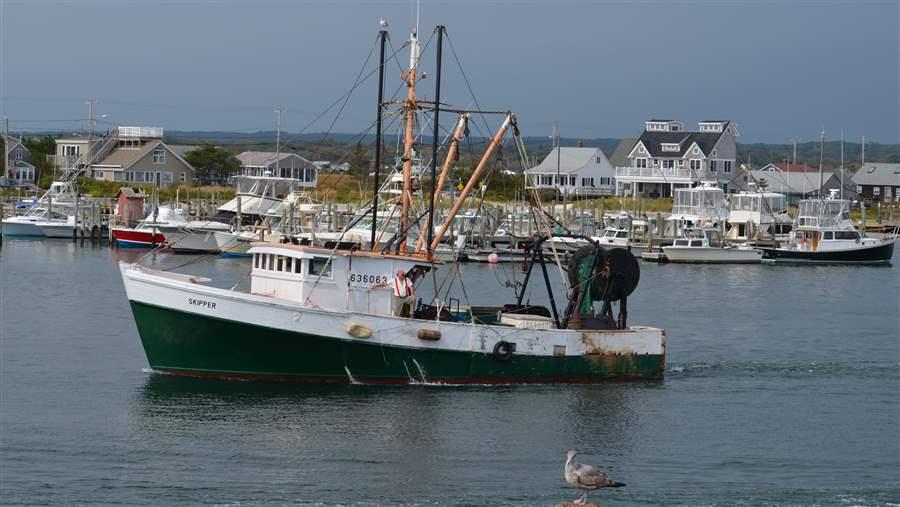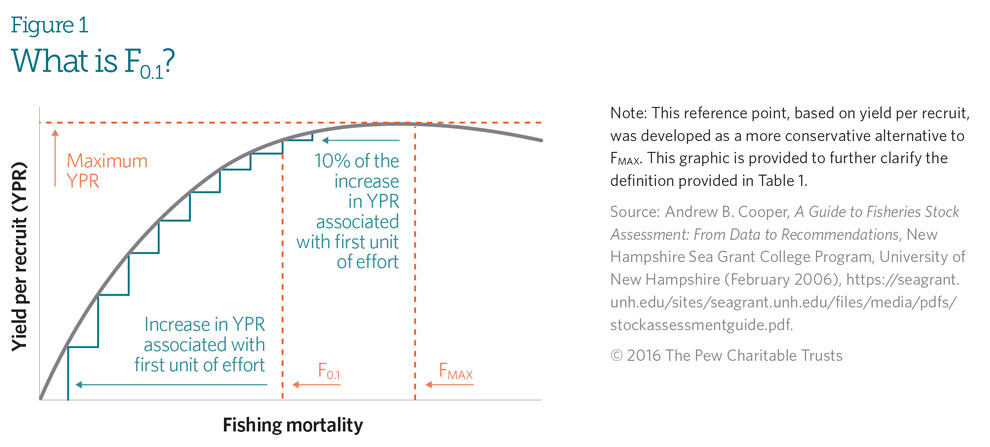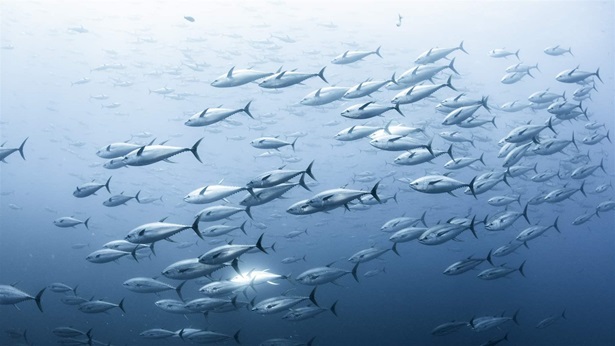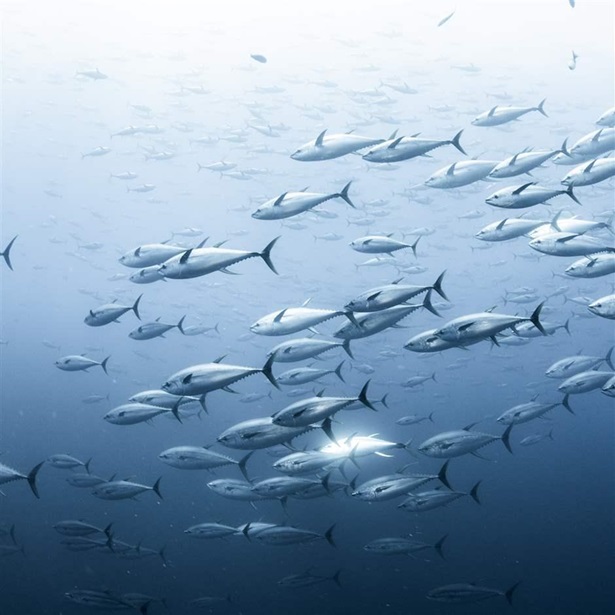Harvest Strategies: Reference Points
Measuring success in fisheries management
 Christine Olson
Christine OlsonReference points are the benchmarks that scientists and managers use to compare the current status of a stock or fishery to a desirable (or undesirable) state.
Overview
Fisheries managers are responsible for ensuring the health of both fisheries and fish populations. How is health defined, and how can success be measured? Through biological reference points, such as the biomass needed to provide maximum sustainable yield (BMSY). Scientists have used reference points for over 50 years to evaluate stock status and now are applying them more broadly; in fact, reference points are emerging as one of the most widespread and effective bases for modern fisheries management.
Setting reference points is a critical step in the development of harvest strategies, because reference points are closely tied to several other strategy components. Reference points are the benchmarks that scientists and managers use to compare the current status of a stock or fishery to a desirable (or undesirable) state, and hence help to determine the success of the harvest strategy. For fisheries with clear management objectives, reference points can be used to assess progress toward meeting those objectives. In some cases, the reference points are set at the beginning of the harvest strategy process, functioning as de facto management objectives.
Managers should choose reference points based on scientific advice, which ideally should be informed by management strategy evaluation (MSE) analyses that assess how well the candidate reference points are likely to perform in the context of the broader harvest strategy. Reference points might not reflect the full suite of trade-offs encompassed within a fishery’s management objectives but can be used to guide development of the harvest control rule (HCR)—the harvest strategy’s operational component—by providing concrete anchor points for the HCR’s management action.
Limit, target, and trigger reference points
In fisheries management, there are three main types of reference points: limit reference points (LRPs, or Blim and Flim), target reference points (TRPs, or BTARGET and FTARGET), and trigger reference points.
Limit reference points should define the danger zone, the point beyond which fishing is no longer considered sustainable. In a well-managed fishery, managers avoid this zone with a very high degree of certainty and, if it is inadvertently violated, take immediate action to return the stock or fishing pressure to the target level. Importantly, LRPs should be based exclusively on the biology of the stock and its resilience to fishing pressure. LRPs should not consider economic factors because the LRP defines the point that the stock should never hit due to threat from a biological perspective. For example, limit reference points can be set to avoid recruitment overfishing, the undesirable state in which adults of a species are so overfished that they cannot reproduce fast enough to replenish the stock.
Target reference points define the ideal fishery state. In a well-managed fishery, management measures should therefore be designed to consistently achieve this state with a high degree of certainty. Given all of the unknowns and uncertainty in stock assessments, and in fisheries management in general, one of the benefits of the TRP is that it can create a sufficient buffer zone to help managers ensure that the limit reference point is not breached. The fishery is likely to fluctuate around the target due to natural variability and uncertainty but should not systematically deviate from it (e.g., consistently be below a biomass target or above a fishing mortality target).1 Unlike in setting a limit reference point, managers and scientists can base the TRP on one or more ecological, social, economic, and/or biological considerations.
Some fisheries also have trigger reference points, which are typically set between the TRP and LRP to prompt additional management response in order to help ensure that the fishery remains close to the target or avoids breaching the limit. It is increasingly common for fisheries managers to formally adopt HCRs that specify a trigger reference point and the resulting management action. Some rules adjust the catch limit in relation to the estimated current stock status and, in effect, give a continuous set of trigger reference points and adjustments. For example, a harvest control rule might continuously decrease allowable fishing mortality as stock status departs from the TRP and moves toward the LRP. However, sometimes the LRP and TRP serve as the only triggers for management action.
Importantly, as uncertainty increases, both target and limit reference points should be set more conservatively. If there is high uncertainty or a less comprehensive monitoring program, the TRP should also be set further from the LRP to create a larger buffer and to reduce the risk of breaching the limit.
Choosing candidate reference points: MSY and beyond
Generally, TRPs and LRPs are divided into two categories: fishing mortality-based (F-based) and biomass-based (B-based). For many decades, reference points have most often been tied to maximum sustainable yield (MSY), defined as the largest average catch that can be taken continuously from a stock under existing environmental conditions. There are two related reference points: FMSY is the fishing mortality rate that eventually results in the largest yield on average (MSY); BMSY is the corresponding average stock size.
One key question that managers face is whether to use F-based and/or B-based reference points when setting targets and limits. Oftentimes, the answer is to use both, because F can be directly managed while B is the critical point to control from an ecological perspective.2 B-based reference points are also often easier for managers and stakeholders to understand, because biomass is usually expressed as an absolute number that relates physically to the quantity of fish in the water, whereas F is a mortality rate that is intangible and cannot be directly observed.
Although MSY is an appropriate basis for reference points in many cases, there are situations in which MSY should not be used, either because it cannot be robustly estimated or because the management objective cases, many other candidate reference points exist to choose from, each with their own strengths and weaknesses. (See Table 1.) Most reference points are calculated from the results of stock assessments, but it is also possible to set empirical, or data-based, reference points that can be directly measured; for example, those related to catch per unit effort (CPUE).
Guidelines for developing and using target and limit reference points are outlined in the United Nations Fish Stocks Agreement (UNFSA) and the Food and Agriculture Organization Code of Conduct for Responsible Fisheries. (See below.) The Marine Stewardship Council also calls on fisheries to be managed with target and limit reference points in order to be certified as sustainable. That guidance can help fisheries choose among the many candidate reference points.
Key Reference Point Principles in the U.N. Fish Stocks Agreement
- LRPs “constrain catches within safe biological limits”; risk of breaching LRP should be “very low”; “if a stock falls below LRP or is at risk of falling below such a reference point, conservation and management action should be initiated to facilitate stock recovery.”
- Design management so that TRPs are achieved “on average.”
- “Fishing mortality rate which generates maximum sustainable yield should be regarded as a minimum standard for limit reference points.”
MSY: Target or limit?
The concept of maximum sustainable yield originated in the 1930s and became mainstream in fisheries in the 1950s. However, the downsides of MSY-based management manifested within just a couple of decades when it became clear that managing for MSY often leads to unsustainable fisheries and suboptimal economics.3 As fisheries expert Ray Hilborn wrote in a 2007 study, “The traditional fisheries management objectives of maximizing yield and employment lead to heavily exploited stocks.”4
By definition, MSY is an average, which is to say there is a 50 percent chance of violating it in any given year. This 50 percent failure potential applies to both BMSY and FMSY. That is, fishing at FMSY only gives a coin flip’s chance of being at or above BMSY and is therefore known to lead to fluctuations around BMSY that can be unsustainable.5 The stock depletion that results can lead to an irreversible loss of genetic diversity and to lower reproductive success as older, more productive individuals are fished out under the structure of traditional fisheries management.6
This begs the question: If reference points are based on MSY (or MSY proxies), should the MSY levels be the target or the limit?
Some fisheries experts advocate for MSY-based limits, not targets, at least for fishing mortality, based on the precautionary approach, the UNFSA, and other international agreements.7 This position is supported by evidence that some fisheries managed for MSY as a target are economically suboptimal and by assertions, such as by Andre Punt and Anthony Smith in 2001, that the only reason MSY has not been “abandoned” in the fisheries management toolbox is that it has changed from a management target to an “upper limit.”8


There is also a growing body of evidence that managing for biomass above BMSY leads to larger fish, similar catch levels, greater economic benefit, and lower adverse ecological impact, providing a compelling case for not breaching BMSY.10 For example, fishing at 0.75*FMSY was found to result in higher stock size (125%-131% of BMSY) at “the expense of relatively small forgone yields” (94% of MSY or higher).11 Similarly, Hilborn in 2009 recommended trading MSY for “pretty good yield,” defined as the range between 0.8*FMSY and FMSY, and adopting a biomass target of 50%*B0, finding little expected loss of yield at these reference points.12
Not only are these targets greater than BMSY good for the stock, but they also help the fishery by reducing fishing costs and increasing stability. That said, management objectives for many fisheries have traditionally focused on targeting MSY instead of establishing it as the limit. Supporters of continuing that approach argue that MSY-based LRPs are unreasonable given uncertainty in stock assessments and that FMSY won’t lead to serious or irreversible fishing impacts as implied by the definition of LRPs.13
Proxies for MSY
Many of the alternate reference points presented in Table 1 are comparable to MSY-based reference points, andare therefore sometimes used as MSY reference point proxies when MSY-based reference points are desired butcannot be confidently estimated.
As a proxy for BMSY, fishery managers and scientists can use reference points based on unfished biomass(B0), with recommended BMSYproxies ranging from 30%14 to 60% of B0, with 40%*B0as the most common.15Scientists recommend the higher percentages for less resilient species.
As a proxy for FMSY, managers and scientists often use reference points based on spawning potential. Therecommended range is F30%-F50%, with even higher percentages for low-resilience species.16For stocks of averageresilience, Wendy Gabriel and Pamela Mace17recommend F40%while Keith Sainsbury18recommends F50%.
Other FMSYproxies include F0.1, half of the natural mortality rate (50%M), and FMAX, though the latter oftenoverestimates FMSYso it can be risky. For example, F0.1is used by scientists at the International Commission for theConservation of Atlantic Tunas (ICCAT) as the FMSYproxy reference point for the eastern stock of Atlantic bluefintuna. An analysis of candidate reference points for this stock found that F0.1was the best proxy for FMSY, while F40%was also robust.19F30%and FMAXwere more biased and less precise, however, so were not deemed by the ICCATscientists to be suitable proxies.
Conclusion
Selecting robust and risk-averse target and limit reference points is a critical step to ensure sustainable andprofitable fisheries in the future. In essence, TRPs protect the economic status of the fishery, while LRPs protectthe biological status of the stock. The result is that failure to achieve a TRP usually results in medium-termreductions in the flow of benefits to fishery participants and consumers, while the costs of breaching a LRP aremuch more serious, ranging from stock decline to collapse, ecosystem destabilization, and/or long-term profitloss (for example, via loss of fishery yield). This is why it is important to use MSE to help select a fishery’s harveststrategy, ensuring that the reference points and associated harvest control rule are designed to best meet thefishery’s management objectives, including the common requirement to avoid breaching the limit referencepoint(s).
Endnotes
- Victor R. Restrepo et al., Technical Guidance on the Use of Precautionary Approaches to Implementing National Standard 1 of the Magnuson-Stevens Fishery Conservation and Management Act, NOAA Technical Memorandum NMFS-F/SPO-31, National Marine Fisheries Service (1998), http://www.nmfs.noaa.gov/sfa/NSGtkgd.pdf.
- Keith Sainsbury, Best Practice Reference Points for Australian Fisheries, Australian Fisheries Management Authority (2008), http://www.afma.gov.au/wp-content/uploads/2010/06/R2001-0999.pdf.
- Peter A. Larkin, “An Epitaph for the Concept of Maximum Sustainable Yield,” Transactions of the American Fisheries Society 106 (1977): 1–11, doi: 10.1577/1548-8659(1977)106<1:AEFTCO>2.0.CO;2.
- Ray Hilborn, “Defining Success in Fisheries and Conflicts in Objectives,” Marine Policy 31 (2007): 153–58, doi:10.1016/j.marpol.2006.05.014.
- Victor R. Restrepo, “Red, Green and Yellow: Thoughts on Stock Status and the ICCAT Convention Objectives,” ICCAT Collective Volume of Scientific Papers 64 (2009): 2663–73, http://www.iccat.int/Documents/Meetings/Docs/SCRS/SCRS-08-172%20Restrepo.pdf.
- Sainsbury, Best Practice Reference Points.
- David J. Die and John F. Caddy, “Sustainable Yield Indicators From Biomass: Are There Appropriate Reference Points for Use in Tropical Fisheries?” Fisheries Research 32 (1997): 69–79, doi:10.1016/S0165-7836(97)00029-5; Wendy L. Gabriel and Pamela M. Mace, “A Review of Biological Reference Points in the Context of the Precautionary Approach,” Proceedings, 5th NMFS NSAW, NOAA Technical Memorandum NMFS-F/SPO-40 (1999), https://www.st.nmfs.noaa.gov/Assets/stock/documents/workshops/ nsaw_5/gabriel_.pdf; Andre E. Punt and Anthony D.M. Smith, “The Gospel of Maximum Sustainable Yield in Fisheries Management: Birth, Crucifixion and Reincarnation,” in Conservation of Exploited Species, ed. John D. Reynolds et al. (New York: Cambridge University Press, 2001); Sainsbury, Best Practice Reference Points; and Davies and Basson, Approaches for Identification of Appropriate Reference Points.
- Andrew A. Rosenberg and Victor R. Restrepo, Precautionary Management Reference Points and Management Strategies, Food and Agriculture Organization (1994), http://www.fao.org/docrep/003/w1238E/W1238E06.htm; and Punt and Smith, “The Gospel of Maximum Sustainable Yield in Fisheries Management.”
- Also reviewed in International Scientific Committee for Tuna and Tuna-like Species in the North Pacific Ocean, Pacific Bluefin Tuna Working Group, Report of the Pacific Bluefin Tuna Working Group Workshop (2010), https://swfsc.noaa.gov/publications/FED/01046.pdf.
- Pilling et al., Consideration of Target Reference Points.
- Restrepo et al., Technical Guidance.
- Ray Hilborn, “Pretty Good Yield and Exploited Fishes,” Marine Policy 34 (2010): 193–96, doi:10.1016/j.marpol.2009.04.013.
- Maunder and Deriso, Reference Points and Harvest Rate Control Rules.
- Pilling et al., Consideration of Target Reference Points.
- Michael C. Melnychuk, Jeannette A. Banobi, and Ray Hilborn, “Effects of Management Tactics on Meeting Conservation Objectives for Western North American Groundfish Fisheries,” PLoS ONE 8 (2013): e56684, doi:10.1371/journal.pone.0056684; Restrepo et al., Technical Guidance; and Keith J. Sainsbury, Andre E. Punt, and Anthony D.M. Smith, “Design of Operational Management Strategies for Achieving Fishery Ecosystem Objectives,” ICES Journal of Marine Science 57 (2000): 731 -41, http://dx.doi.org/10.1006/jmsc.2000.0737.
- Gabriel and Mace, “A Review of Biological Reference Points”; and Restrepo et al., Technical Guidance.|
- Gabriel and Mace, “A Review of Biological Reference Points.”
- Sainsbury, Best Practice Reference Points.
- Kell and Fromentin, “Evaluation of the Robustness of Maximum Sustainable Yield Based.”













